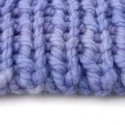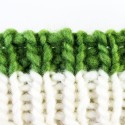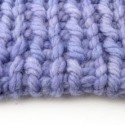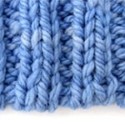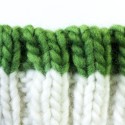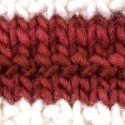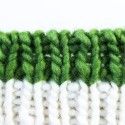Premium Video
Figure-8 Cast-On
Premium Video
The matching bind-off for this and all double-sided cast-ons is Kitchener Stitch.
Garter Tab Cast-On for Triangular ShawlsFree Video
The Garter-Tab Cast-On shown on my favorite beginner lace shawl: the Show Your Colors shawl.
 Invisible Circular Cast-On
Invisible Circular Cast-OnPremium Video
Invisible Ribbed Bind-Off for 1×1 Rib
Premium Video
If you already know Kitchener Stitch, you’ll have a good foundation for this bind-off. However, it’s not a prerequisite.
Speaking of which, there are no prerequisites in this course – you can jump in wherever you want as long as you can knit and purl and you have an adventurous attitude.
The main thing to keep in mind as you learn the Invisible Ribbed Bind-Off is to take a deep breath, go slow, and KNOW you can do it.
Don’t expect yourself to memorize all the moves right away. It will help you to think of the bind-off as consisting of only 2 basic movements.
Make a swatch of at least 30 stitches so that you can really practice this. As you go, repeat the mantra “knit-off purl, purl-off knit,” “knit-off purl, purl-off knit” in your head as you do these movements, and you will never forget what to do.
Warning: If you’re using a delicate yarn like any single-ply yarn like Noro (which has a tendency to break anyway) or even Malabrigo Worsted, be careful on this bind-off. Don’t work very many stitches before you pull your yarn tight or it might break. Just do one move and then tighten your yarn, and you’ll avoid that problem.
This bind-off, like all sewn bind-offs, is painstaking to undo. If you need to undo this bind-off, just backtrack slowly and check to make sure it looks right as you go.
This is a pretty advanced bind-off so pat yourself on the back if you give it a try — whether or not you succeed at first. Well done!
Download an illustrated guide to the Invisible Ribbed Bind-Off here.
Make sure you watch your tension on this bind-off. Give the bound-off edge a tug every so often as you go to get a feel for how you are doing.
The nice thing about this bind-off is that you can “make up for” bad tension – if you do a few stitches too tight, you can do the next few a little loose, and things will sort of even out.
Italian Tubular (Invisible Ribbed) Cast-On for 1×1 RibPremium Video
Matching bind-off: Invisible Ribbed Bind-Off for 1×1 Rib.
Italian Tubular Cast-On for 2×2 RibPremium Video
This cast-on is special in that it has a matching bind-off: the Kitchener Double-Rib Bind-Off.
Judy’s Magic Cast-On (JMCO)Free Video
To do Judy’s Magic Cast-On (JMCO) for Two-at-at-Time Toe-Up Socks, see this video.
The matching bind-off for this and all double-sided cast-ons is Kitchener Stitch.
Judy’s Magic Cast-On (JMCO) for Two-at-a-Time KnittingFree Video
The matching bind-off for this and all double-sided cast-ons is Kitchener Stitch.
Kitchener Double-Rib Bind-OffPremium Video
The trick to this bind off (and it’s only a little scary) is to take the stitches off the needle and slide them onto two needles – one needle into the knits (which will naturally come forward) and one needle into the purls (which naturally recede).
Then all that remains is to bind off the stitches with Kitchener Stitch (which I show you in this tutorial as well as in its own place in this course).
Take it from me that this technique is about 100 times easier than the Invisible Ribbed Bind-Off for 2×2 Rib.
Russian Grafting (Bind-Offs Class)Premium Video
You’ll be using a crochet hook to do this bind-off which makes it go really fast. Use a crochet hook that is the same size as your needles, not smaller. This will make the bind-off more even.
You’ll need to transfer the working yarn to the other end of your needles before you start this bind-off, which I will show you how to do.
The trick here, as with most of the seaming bind-offs, is to get comfortable managing stitches on not one but two needles, and pushing the stitches to the tips of the needles without stretching them.
Pointy needles can be a bit painful in this case – you may want to use traditional needles like the Addi Turbos I use in the tutorial here.
Three-Needle Bind-OffPremium Video
Because you have to handle three needles at once, this is a intermediate-to-advanced bind-off. It is one that I would consider “required reading” for intermediate-level knitters.
It would be smart to learn this bind-off before attempting the related but more-challenging Three-Needle I-Cord Bind-Off.
Tip: Use a smaller needle as the third needle. This will make it easier to get into the stitches on the left hand needles. If you use all blunt needles it’s going to be a little bit tricky.
Tubular Bind-Off for 1×1 RibPremium Video
The premise of this technique is that you do a couple set-up rows, then separate the stitches onto 2 needles (easier than it sounds), and then bind them off invisibly with Kitchener Stitch.
If you don’t know Kitchener Stitch, it’s worth learning so that you can have this bind-off in your arsenal.
As far as speed goes, this is a sewn bind-off, which means that it is slow (pretty much all sewn bind-offs are slow). But I think that if you’re fast at Kitchener stitch you’ll find that this bind-off can be fast as well.
Another drawback is that this bind-off, like all sewn bind-offs, is painstaking to undo. If you need to undo the Kitchener-stitch portion of this bind-off, just backtrack slowly and check to make sure it looks right as you go.
A potential drawback to the Tubular Bind-Off is that if you are binding off a lot of stitches (probably on a circular needle), it may be cumbersome to take them all off and put them onto two separate needles before binding off.
If you decide to do it anyway but you don’t have two of the same-sized circular needles handy, don’t worry about that — you can slip the stitches onto smaller needles or even needles of two different sizes.
Options For This Bind-Off
You can do either a 2-row or a 4-row setup before you work the Kitchener stitch portion of this bind-off.
The 4-row setup will give a fuller, rounder look to the edge (and also match a Tubular Cast-On done with 4 setup rows).]
The bind-off pictured above used a 2-row setup (which seems sufficient to me).
If you are binding off in the round, you will need to work the setup rows in the round.
On the first round, slip the purl sts wyif, and on the second round, slip the knit sts wyib.
Warning: It’s important that you don’t do the Kitchener stitch part of this bind-off too tight. That would really interfere with the stretchiness of this bind-off.
Turkish Cast-OnPremium Video
The matching bind-off for this and all double-sided cast-ons is Kitchener Stitch.
